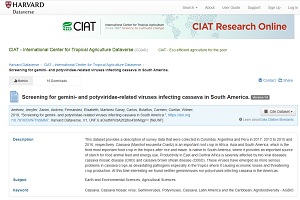Screening for gemini- and potyviridae-related viruses infecting cassava in South America.
This dataset provides a description of survey data that were collected in Colombia (2017), Argentina (2013 to 2015) and Peru (2016). Cassava (Manihot esculenta Crantz) is native to South America, is the third most important food crop in the tropics after rice and maize and has become an important food security crop in Africa and Asia. Viruses are the cause of two of the most important diseases affecting this crop. Productivity in East and Central Africa is severely affected by Cassava Mosaic Disease (CMD) and Cassava Brown Streak Disease (CBSD). The viruses that cause these diseases belong to virus families Geminiviridae and Potyviridae, respectively. Related viruses causing CMD have been reported only in Africa, Asia and recently in Southeast Asia. Meanwhile, cassava-infecting potyviruses seem to be restricted to West-Africa. No isolates of these virus families, nor related diseases have yet been reported infecting cassava in the Americas. At the same time there are no reports on specific surveys for these viruses in cassava samples collected in the Americas. We used validated diagnostic protocols for cassava geminivirus and potyvirus detection, to screen for these viruses in samples from Colombia, Argentina and Peru. None of the samples was positive for gemini- nor potyviruses, while other viruses previously reported in these countries, were readily detected.

